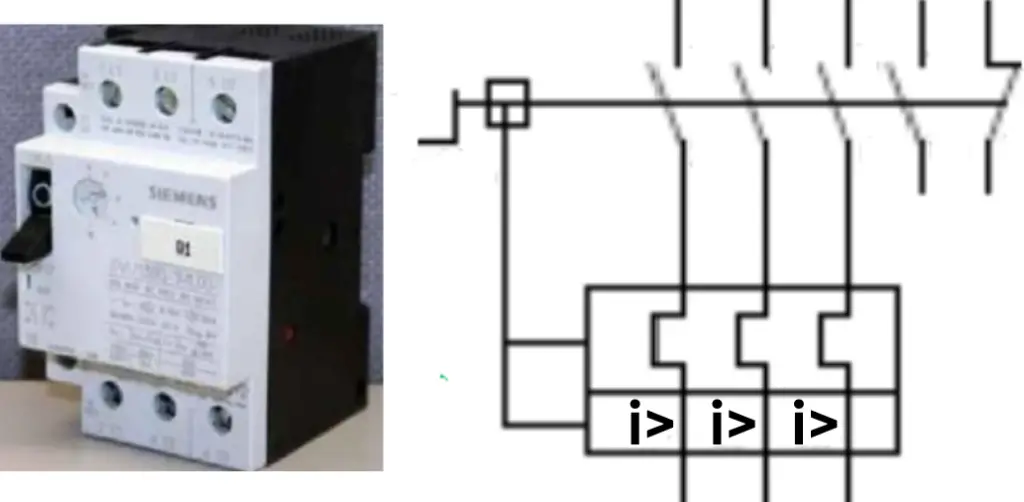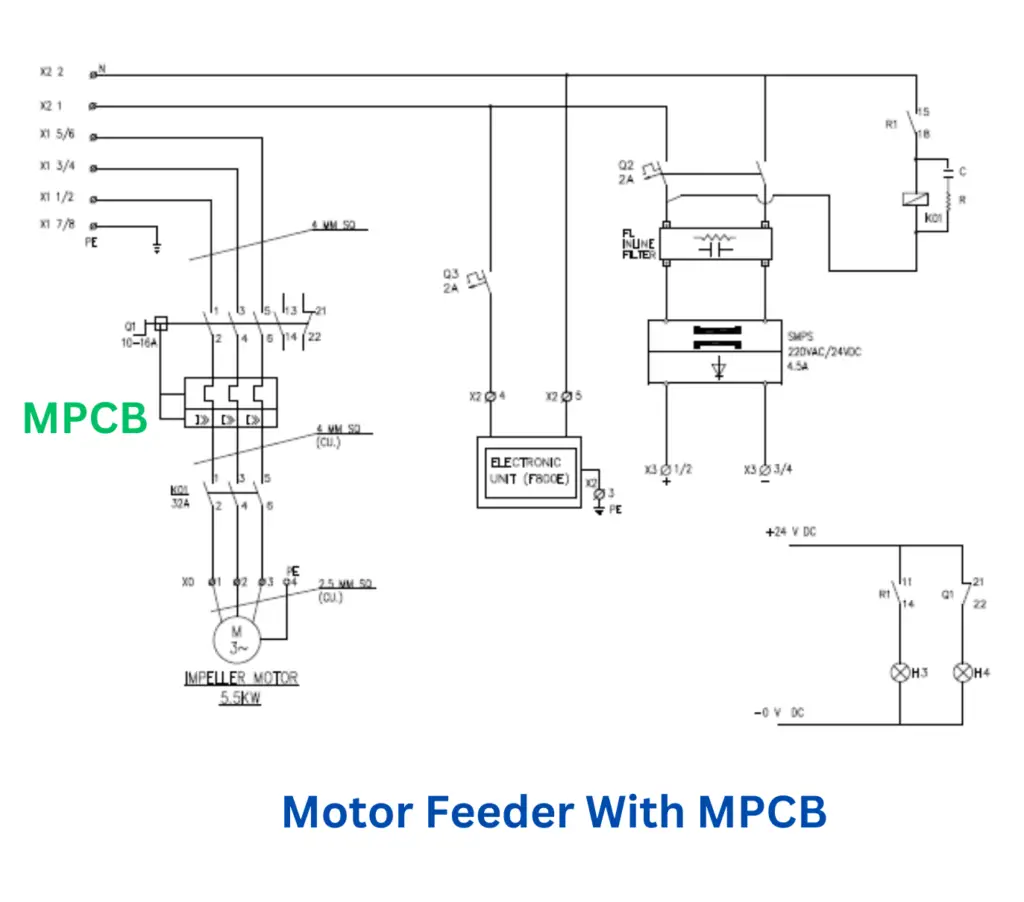Motor Protection Circuit Breaker (MPCB) is an electrical protection device specifically designed for electric motors. Since electric motors have a wide range of applications and are used to power mechanical devices of all kinds, it is crucial to protect them with MPCBs. Below are just a few examples of devices powered by electric motors in commercial and industrial buildings:
- HVAC equipment includes Rooftop air conditioners, chillers, compressors, heat pumps, and cooling towers.
- Air handling units such as extraction and injection fans are needed.
- Water pumping systems.
- Hoisting devices -Elevators, electric cranes and Hoists
- Industrial belt conveyors, chain conveyors, rotary airlocks, drag chains
In industrial and commercial applications, the MPCB is crucial in providing electrical protection to electric motors.

Motor Protection Circuit Breaker and its Functions?
A Motor Protection Circuit Breaker (MPCB) is a specialized electromechanical device that can be utilized with motor circuits of both 50 Hz and 60 Hz frequencies. It has multiple functions enable it to deliver a safe and secure electrical supply to motors.
- The Motor Protection Circuit Breaker (MPCB) can interrupt electrical faults, such as short circuits, line-to-ground, and line-to-line faults if they are below their breaking capacity.
- Motor overload protection occurs when an electric motor draws a current higher than its rated value for a prolonged period. It is typically adjustable in MPCBs.
- .Phase unbalances and loss protection. MPCB disconnects the motor upon detection of either fault.
- After an overload, a thermal delay prevents the motor from being turned back on immediately. This gives the motor time to cool down and prevents it from being permanently damaged.
- Motor Protection Circuit Breakers (MPCBs) typically include buttons or dials for circuit switching.
- Motor protection circuit breakers usually come equipped with an LED display that lights up whenever the circuit breaker trips due to a fault. This LED serves as a visual warning for nearby personnel, indicating that a fault has occurred and that the electric motor should not be reconnected until the fault is resolved.
- Electric motors are valuable equipment, and it’s important to protect them with a motor protection circuit breaker (MPCB). An overload could damage the motor without proper protection, leading to costly repairs or even replacing the entire equipment. Some MPCB models have an automatic reconnection feature that allows the motor to restart after a cool-down period, thus preventing any further damage. Using an MPCB to protect your electric motor can ensure a longer lifespan.
Motor Protection Circuit Breaker Working Principle
The motor protection circuit breaker is a subtype of thermal-magnetic circuit breaker with additional functions designed to protect electric motors. Its basic working principle is similar to other circuit breakers.
- Thermal protection is an essential safety feature for electric motors. It uses an expanding and contracting contact that disconnects the motor if excessive current is detected. It is important to note that thermal protection does not immediately respond to high inrush currents when a motor starts. Rather, it has a delayed response that allows for this initial surge. However, if the motor cannot start, thermal protection will trip in response to the extended inrush current.
- Unlike thermal protection, magnetic protection immediately disconnects dangerous fault currents during a short circuit, line fault, or other high-current electric fault.
- The main difference between the Motor Protection Circuit Breaker (MPCB) and other circuit breakers is that the MPCB can protect against phase unbalance and phase loss. Three-phase circuit motors require three live conductors with balanced voltages to operate effectively. An imbalance of more than 2% can harm the motor’s service life. If one of the phase voltages is suddenly lost, it can cause even more damage because the motor will continue to run with only two phases. The motor protection circuit breaker can detect these conditions by measuring the differences among phase voltages and can disconnect the motor immediately when they occur. It’s important to note that phase current unbalance is normal in three-phase systems that power separate single-phase loads but is unacceptable when the three-phase circuit powers an electric motor.
- MPCBs come with a manual interruption mechanism that allows for disconnection of electric motors during maintenance or replacement.
- Motor protection circuit breakers come in various current ratings, and many models offer adjustable current ratings. These breakers can be configured to protect motors of different capacities, making them a versatile option for motor protection.
Symbol of Motor Protection Circuit Breaker
The symbol of motor protection circuit breaker(MPCB) is shown in the image below,

Asynchronous Motor (Induction Motor) Protection
The majority of motors employed in the industry are asynchronous motors or squirrel-cage induction motors. These motors use three-phase power to produce a rotating magnetic field, which magnetizes the rotor and creates rotational motion. When designing the electrical protection for an asynchronous motor and selecting motor protection circuit breakers, several crucial factors are not present when safeguarding other types of electrical circuits.
- During startup, asynchronous motors require establishing a rotating magnetic field, leading to a very high inrush current. This current can spike to 500-800% of the rated value for a few fractions of a second. Due to this, magnetic protection trips at values greater than 10 times the rated current, unlike miniature circuit breakers that trip at values as low as 3 times the rated current. A circuit breaker other than an MPCB will not allow the motor to start before the magnetic protection trips. To reduce the inrush current, it is common practice to complement the motor protection circuit breaker with a reduced voltage motor starter.
- Asynchronous motors require a balanced voltage across their three-phase conductors to function properly. If the unbalance exceeds 2%, it can damage the motor over time and reduce its service life. Additionally, the motor may overheat, leading to additional energy expenses due to waste heat. Therefore, a motor circuit breaker that detects phase imbalances and disconnects the motor to prevent damage is necessary.
- If one of the phases gets disconnected, the motor may keep running, but the current in the remaining two phases will rise above the rated value due to a voltage imbalance. This may result in damage to the motor’s windings. Therefore, it’s crucial to have motor protectors that can detect phase loss or phase imbalance and trip immediately. Typically, the differences in current among the phase conductors are measured to detect any imbalance. If one of the phase currents rises or drops considerably compared to the other two, it indicates an unbalance. Similarly, if one of the phase currents drops to zero while the other remains, it denotes a phase loss.
It is common practice to use a contactor and motor protection circuit breaker together to enable automatic motor startup and disconnection control. Additionally, an under-voltage protection device could be incorporated into the system to disconnect the motor if the voltage drops considerably below the rated value.
Motor Protection Circuit Breaker Sizing (Selection Guide)
The size of the motor protection circuit breaker is adequate depending on the motor’s nameplate voltage and current. MPCB manufacturers usually provide charts that present the circuit breaker’s technical specifications to simplify the selection process. The current values of the thermal and magnetic protections are displayed in the thermal release and magnetic release columns. Before installing an MPCB, it is crucial to ensure the voltage and current ratings are compatible with the rating of the protected motor.
- Ensuring the Motor Protection Circuit Breaker (MPCB) voltage rating matches the motor’s nameplate voltage is important. MPCBs are generally available in various voltage ratings, including 230V, 380V, 415V, 440V, 500V, and 660V AC.
- Once you know the voltage of an electric motor, it’s important to check its nameplate current. Remember that the actual operating current may be lower than the nameplate current, especially if the motor is not fully loaded. However, selecting the motor protection circuit breaker (MPCB) based on the nameplate current value is crucial to allowing the inrush current when the motor starts. For instance, a motor with a nameplate current of 30 amperes may draw a much lower current during part-load operation, but the MPCB must be selected based on the rated value of 30 amperes. Otherwise, it may trip if the motor is used at its full load.
- Motor protection circuit breakers are designed to prevent damage to electric motors by interrupting the power supply when the current exceeds a safe level. These breakers can be calibrated to the exact current value required for the protected electric motor. Typically, they have an adjustable range, allowing for versatility in usage. For instance, an MPCB rated at 45 amperes may protect motors with rated currents as low as 30 amperes. This feature is particularly useful when an electric motor is replaced with a more efficient model that requires a lower current, as the motor breaker will not need to be replaced.
- It is important to ensure that the wiring used with a motor protection circuit breaker is appropriately sized. The wire must carry the rated current safely to provide adequate protection. If the wire is undersized, it may overheat, melt the insulation, and cause electrical faults, even if the breaker is properly installed and sized according to the electric motor being protected.
Selecting the right size of Motor Protection Circuit Breaker (MPCB) is crucial to ensure effective and reliable motor protection. An undersized MPCB prevents the motor from even starting, while an oversized MPCB may fail to detect over-current conditions for the motor it is meant to protect.
Motor Protection Circuit Breaker Specification Chart
Manufacturers of MPCBs usually offer charts that present the technical specifications of the circuit breaker, making it easier to select the right one.
It is crucial to ensure that the motor’s voltage and current ratings are compatible with the values at which the thermal and magnetic protections operate, displayed in the thermal release and magnetic release columns. This verification should be done before installing an MPCB to ensure optimal protection.
Types of MPCB:
According to Phase: Single Phase, Three Phase
According to Motor Rating: Single-phase motor capacity, Three-phase motor capacity
According to protection devices: Thermal and Magnetic protection, Magnetic protection
Motor Protection Circuit Breaker Parts

Image source: ipcsautomation
- Thermal over-current release
- Electromagnetic over-current release
- Main contact system
- Auxiliary switch position
- Switch latch
- Arcing chamber (de-ion plates)
- Plunger armature
- Differential trip slide
How to WIre MPCB in a motor control circuit?
Below is the diagram that shows the wiring of a Motor Protection Circuit Breaker (MPCB) in a motor feeder.

- All three phases should be connected to the Motor Protection Circuit Breaker (MPCB).
- The motor protection circuit breaker (MPCB) output is connected to a contactor.
- The contactor outputs three-phase power to the motor.
The use of MPCB eliminates the need for fuses as it protects the motor from overloads and short-circuits, which are the functions of fuses. You know fuse protects the motor and electrical circuits against short circuit.
Conclusions of Motor Protection Circuit Breaker
Motor protection circuit breakers play a crucial role in ensuring electrical safety. They protect motors used in a wide range of applications in commercial and industrial settings.
Asynchronous motors are the most commonly used type of electric motor in industrial and commercial settings. They have specific protection requirements that can only be met by a motor protection circuit breaker (MPCB). You can also use under-voltage protection, timers, and reduced-voltage motor starters in conjunction with MPCBs to provide additional protection or automation.
Selecting the appropriate MPCB is crucial to ensure effective motor protection. If the MPCB is too small, it won’t allow the motor to start, while an oversized MPCB may not be able to detect over-current conditions for the specific electric motor being protected.